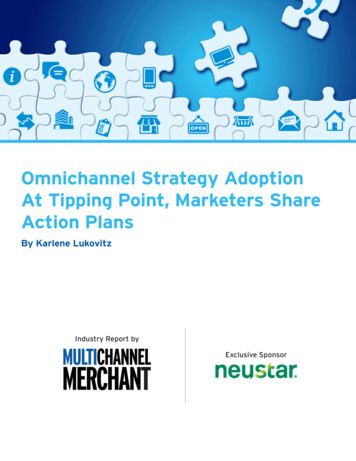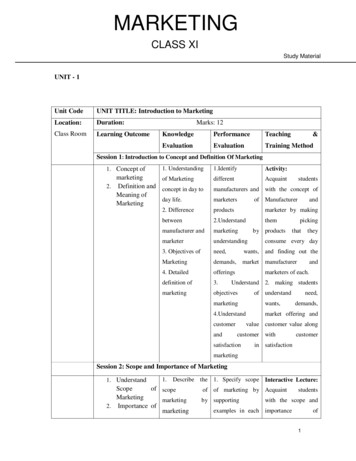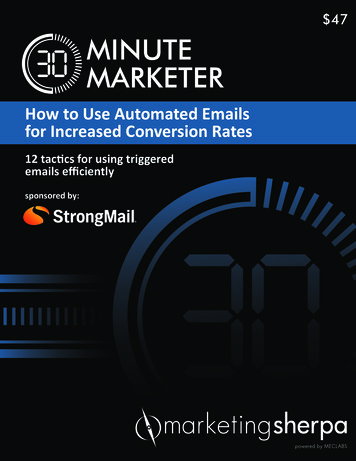
Transcription
The OmnichannelMarketer’s Growth Roadmap
ContentsAll In on OmnichannelSuccess One Channelat a TimeThe Roadmap toOmnichannel GrowthWhy the OmnichannelRoadmap WorksSummary0406101418
IntroductionOmnichannel is not just another buzzword to ignore. It’s a marketing objective, andif you don’t have a strategy in place, you’re already behind the curve; not only is itimportant, it also takes time. There is no omnichannel switch to throw, no simplebutton to push. A sound omnichannel approach must be built step-by-step, and formany companies it all starts with email.Think email is old news? Think again. There’s nothing boring about the number-onedigital channel for delivering marketing revenue.When we look at today’s most successful marketing strategies, they all takean omnichannel tack that puts customers at the center of a diverse network ofinteractions and engagements. Although these strategies use multiple channels anddevices to reach customers, the messaging and overall shopping experience areunified, consistent, and highly personalized for each individual shopper.But how exactly do these companies achieve successful omnichannel marketing?At Emarsys, we answered this question by looking at our most successful customersto identify commonalities among their omnichannel strategies. Few companies startedout trying to build a complete marketing philosophy all at once. Most companies,instead, conquered just one channel at a time, and the most important first step ontheir shared road to omnichannel excellence began with email.Introduction 3
The Omnichannel Marketer’s Growth RoadmapAll In onOmnichanneltry to explain omnichannel, the bottom line is that successful omnichannel strategies all have onething in common: they exist to serve the customer. When the customer wins as the result of aunited, consistent, personalized marketing effort that pulls in data from a variety of channels, youhave effectively created a successful omnichannel strategy.Omnichannel is the evolutionary culmination of traditional marketing,e-commerce, and multi-channel strategies, fueled in many ways by theAny company brave or smartenough to take on omnichannelstands to garner an incrediblecompetitive advantage.21st Century. Today, 51% of Americans prefer to shop online. During the2017 and 2018 holiday seasons, more people purchased online thanthose who bought products in-store. By Q4 in 2018, online sales growth
The Omnichannel Marketer’s Growth Roadmapwas at 15.5%, trumping the previous three years e-commerce growthrate.Still, despite these impressive statistics, the rise of omnichannelimplies that e-commerce and related revenue will soar even higher inthe coming years. Forrester, for example, expects online and webinfluenced retail sales to grow 58% by 2022.However, with the average e-commerce conversion rate for US onlinestores between 2% and 3%, online channels won’t do it alone.Brands still rely heavily on both online and offline revenue, becausealthough 96% of Americans shop online, 64% of a consumer’s averagebudget is still spent in-store, versus 36% online. It’s not offline vs. online.It’s offline online.Customers Want It AllOmnichannel isn’t about what marketers need; it’s about whatcustomers want.Even though most consumers may not even fully understand whatomnichannel means, they certainly enjoy the benefits of a marketingstrategy that delivers unified options and experiences for bothresearching and buying. Where the average consumer 15 years agotypically used two touchpoints when buying a product, today they usean average of five to six touchpoints, which may also represent five tosix different channels.For this reason, online and offline channels continue to be tied to eachother: While 94% of consumers conduct online research prior to buying(referred to as “webrooming”), they still typically like to visit aphysical store to make the purchase. Lately, using a smartphone to buy or reserve an item online andthen pick it up in-store has become more popular, with 70% of USonline shoppers taking advantage of such options. 70% of US shoppers consider the in-store experience the mostimportant channel when making a purchase.Online and offline channels continue to become more interconnectedand complimentary to each other, making omnichannel so much morethan a trend. It’s an inevitable approach to marketing for any companythat hopes to succeed in the future. 90% of customers expect consistent interactions across channels. 64% expect real-time assistance, regardless of the channel, with61% reporting frustration if they could not easily transfer from onechannel to another when interacting with a customer service rep. 45% expect in-store sales staff to be knowledgeable about onlineonly products. 27% would be very likely to leave a store and go to a competitor if aproduct is out of stock, with 21% stating they would buy online froma different retailer.Perhaps these expectations arise as a quid pro quo for all theinformation customers are required to provide businesses whenthey purchase products. Or maybe lightning-fast technology in otherareas of life has made shoppers impatient. Regardless of the reason,at least 50% of consumers say they appreciate having their profileinformation available across all channels when it delivers a consistentshopping experience from one channel to the next. They’re willing toprovide personal data in return for exceptional, personalized shoppingexperiences.The Omnichannel OpportunityAny company brave or smart enough to take on omnichannel standsto garner an incredible competitive advantage.According to a Forrester report, a minority of companies are activelytaking advantage of omnichannel benefits. A mere 32% of retailers surveyed offer customers the ability to viewinventory info for in-store products. Only one third of retailers have mastered the basic operations ofin-store pickup, cross-channel inventory visibility, and store-basedfulfillment. Only 39% of retailers have trained and enabled their sales staffto look up product information for shoppers, despite half of allconsumers that visit a physical store expect this capability. 40% of retailers have difficulty integrating back-office technologyacross channels.Now that we have established why omnichannel is so important, let’slook at how marketers who have typically focused on email can buildon that foundation to implement an effective omnichannel strategy.Other customer expectations of an omnichannel world include:All-In On Omnichannel5
The Omnichannel Marketer’s Growth RoadmapSuccess OneChannel at a TimeEmarsys analyzed the accounts of our most successful clients, and found that many of theiromnichannel strategies started with email. Large enterprise companies have a great deal ofresources they can devote to omnichannel, but even they have to follow a logical course ofdevelopment.For other companies, this is a more challenging hurdle to overcome. The key is to break down theomnichannel roadmap into separate, achievable stages. Maybe you’re a smaller business taking aDIY approach to email, and you’re unsure how you’ll grow your client base. Or maybe you’ve got anemail strategy already in place with a third-party service provider, and you’re ready to graduate to thenext level. Either way, our roadmap to omnichannel growth directly addresses your challenges andprovides a framework for success, starting with email.Think of it this way: If omnichannelis the roof under which allof a customer’s shoppingexperiences are housed, thenemail is the foundation that thoseexperiences must be built upon.
The Omnichannel Marketer’s Growth RoadmapStep 1: Email FirstEmail’s old news, right? As one of the first “apps” created, email hasbeen around in one form or another since the 1970s. We know allthere is to know about it, and have since moved on to the web, mobiledevices and apps, and social media. It makes you sleepy just thinkingabout it, right? Wake up!Email is still the killer app, the largest social network on earth, and the#1 ROI digital channel. The next closest competing channel is pay-perclick (PPC), which only drives about half as much revenue as email.With so many marketing avenues competing for our attention, it can bedeceptively tempting to overlook the fact that, despite SMS and otherinstant messaging services, email is still being used every day, everyhour, every minute. In marketing, it continues to be a very profitableway to interact with customers and drive purchasing, and it’s centralto omnichannel growth. Think of it this way: if omnichannel is the roofunder which all of a customer’s shopping experiences are housed, thenemail is the foundation that those experiences must be built upon.YOUR EMAIL ADDRESS IS YOUR DIGITAL IDThink back over the last 12 months. How many times have youprovided an email address when making a purchase (online or in-store),applied for a job, signed up for a loyalty program, or filled out patientforms at a doctor’s office? Sure, email is a reliable way to communicate,but it’s also a really effective way to identify customers. While it’s truethat not everyone in the world has an email account, every onlineshopper does. For this reason, a customer’s email address is widelyrequired as a form of user verification, a digital ID, if you will, with whichmarketers can note online behavior, the devices a customer prefers touse, the times they are most receptive to marketing email, and dozensof other metrics consumers generate every time they go online.Personalization: the foundation of customerexperienceIt should be no surprise that 80% of consumers prefer buying frombrands that personalize the shopping experience. Personalizationfeatures are the marketer’s goldmine because they allow the marketerto easily segment target audiences in meaningful, data-driven ways.Such functionality is changing the very role of the marketer, by enablingthem to leverage customer data to interact with customers on a 1:1basis. Things like personalized incentive and product recommendationsare not only possible, but also made scalable with the help oftechnology. Artificial intelligence marketing (AIM) makes it possible toscale all these personalization components beyond human capacity,and even eliminate one-to-many marketing. Essentially, personalizationrevolutionizes the marketer’s role, while simultaneously improving theconsumer’s brand experience.Failed deliverability: missed revenueopportunityEmail is unique because it is a giant global delivery and communicationplatform, whose technology works the same no matter where you areon the planet; that can’t be said for any other channel. However, foremail to work, it must reach its intended recipients.If an email doesn’t make it to an inbox, it doesn’t matter howpersonalized or timely it is, it’s a missed revenue opportunity.With roughly 12,000 ISPs managing infrastructure, each ISP has its ownset of bounce codes and policies for accepting email, which contributesto the more than 20% of emails that never make it to their destination.If you send out 12,000 emails a month, 2,400 of them are bringing inno revenue. That’s why deliverability, though often taken for granted,is of critical importance. At Emarsys, we develop our deliverability andreporting tools around a global footprint, and we only allow senderswith quality reputations onto the platform. This helps us keep thepathways open between our customers and their customers.Innovation: 100% targetingEven when marketers achieve above-average open rates somewherebetween 20% - 30%, this still means their emails are not of interest to70% - 80% of their target audience. How can marketers reach thosepeople?Email offers a way to hone in on the gaps in audience engagement. Dataabout engagement (or lack thereof) in an email campaign can be usedin continued attempts to engage with unresponsive individuals acrossother channels that may be more effective.While a customer may ultimately end up responding to a CRM ad orSMS notification, it was email data that helped the marketer understandthere might be a better way to interact with them.At this stage on the omnichannel roadmap, the basic email system isoptimized, and marketers may feel ready to pivot to the next logicalchannel: the web. But omnichannel excellence is a step-by-stepprocess, and before you can focus on the web as a channel, you mustfirst consolidate and organize customer data from the wide range ofpossible touchpoints.To do so, pull all available data into a single database that createsunified profiles for each individual, all built upon the unique digital IDscommon across all channels: their email addresses.Success One Channel at a Time7
The Omnichannel Marketer’s Growth RoadmapStep 2: DataDuring this phase of the roadmap, use your data to first improve your email by further fine-tuningyour optimization. From then on, data will fuel your company’s journey throughout the omnichannelroadmap.Data is your most valuable asset; leverage it to personalizecommunication with customers and deliver a world-class shoppingexperience. To accomplish this, your database must be carefullyconstructed, fed accurate information, and meticulously maintained.The question is, how? Many retailers have hundreds of thousands, evenmillions, of contacts in their databases. How can a marketer possiblybegin to manually keep all that data current and accurate? They can’t.CLOUD DATADATACLOUDSTORAGESTORAGEToday’s cloud data storageoffers a powerful but easy-to-usedatabase framework, organizedaround each customer’s digitalID and continuously fed throughintegrations with various datasources, including website ande-commerce site activity, socialmedia, app usage, and even in-storepurchases. This data automaticallyflows into the unified database,updating each individual’s profile.UNIFIEDUNIFIEDDATABASEDATABASEDATA SOURCES8Success One Channel at a Time
The Omnichannel Marketer’s Growth RoadmapAPRCUSTOMER’SPROFILEMAIJUNE 500700JULYAs all this data flows into the unifieddatabase, it continues to create moredetailed and in-depth profiles of eachcustomer. For example, at Emarsys,a segmentation engine accompaniesthe cloud-based database. This engineallows marketers to easily automatetags assigned to customers accordingto key variables and patterns, such asfrequency of purchase, average dollarsspent per purchase, and monthly andannual purchase values.With a segmentation engine like this,you can go beyond simply collectingdata, and make it work for morestrategic actions by both Marketing andSales departments. It helps you betterunderstand each buyer’s purchasingbehavior, automate segmentation andcommunication using blueprints orworkflows, and create more effective,highly personalized interactions. This, inturn, improves response rates, reducescosts, generates higher marketing ROI,and drives overall revenue.At this point, you should have the basics of a powerfulomnichannel engine that is fed with data, and uses it to createmore effective, more personal email campaigns. As a result, theseemails, along with other channels, provide a steady flow of valuabledata that is collected in a single database. With this system inplace, you can now begin to look at the next stage in the path toomnichannel excellence: web.Success One Channel at a Time9
GewroCwhtah nnRoeald: Tmhape WebStep 3: Web ChannelStep 4: MobileWith a sound foundation of email and data, you can begin to focusstrategically on web as a channel.The mobile channel has exploded over the last five years, continuouslygrowing as other conduits concurrently lost ground.Here, customer relationships are still built upon digital IDs, but nowyou’re able to further enrich each customer’s brand experience withcustomized web experiences, including personally relevant targetedads, tailor-made product recommendations, and meaningful incentives.We are in a mobile-first era already, and many argue that we’re headingquickly toward a mobile-only world.Along the same innovative lines as 100% targeting with email, you cannow focus on gaps in online purchasing, such as abandoned carts. In2015, 65% of retailers had a cart abandonment rate higher than 50%,and the abandoned cart rate average has since climbed to 78%.But why are your customers abandoning those carts? Did they find theshipping fees too high? Were there requirements forced upon them aspart of the checkout process they didn’t like? Did your website crash?Did they try to checkout using a browser or device that isn’t compatiblewith your site? Addressing all those lonely abandoned carts andunrealized revenue is impossible without knowledge of each customer’sreasoning.The fact that customers aren’t making it far enough in the shoppingexperience to actually make a purchase is bad enough, but it’s far morecrushing when you calculate the value of all that merchandise theyleave behind. We’re talking billions of dollars in potential revenue.Online shoppers abandon carts 39% of the time due to complicatedcheckout forms and processes. Perhaps you need to rethink yourcheckout system; looking for ways to simplify it and back it up withan automated email system that will reach out to customers with aspecial offer at the best possible moments. After all, 54% of shopperswill purchase products left in shopping carts if those products areoffered at a discounted price. When a company can streamline itscheckout process, conversion rates go up – by as much as 35% for anaverage large e-commerce company – and marketers gain a real shotat recovering an estimated annual 260 billion worth of lost orders.The best examples of omnichannel excellence optimize email, build anengine on unified customer data, use that data to create personalizedweb experiences, then begin looking for ways to reach customerswhenever and wherever they will be most receptive.This brings us to the next stop on the omnichannel roadmap: mobile.10Success One Channel at a TimeRegardless, the mobile channel is more important for marketers todaythan it ever has been before.Here’s why: In 2017, mobile made up 34.5% of total U.S. e-commercesales, and just one year later that number rose to 39.6%. On theapplication side, 66% of mobile sales are attributed to mobile app salesfor retailers with both a mobile website and app.Remember, it’s the consumers who are demanding this growth ofmobile as a channel, not marketers. They are leading the charge withtheir dollars. Marketers must respond in-kind, providing the buyingoptions and unified experiences customers are seeking. Make nomistake, though, mobile marketing today is about so much morethan a mobile-friendly website. It’s about SMS, push notifications, appexperiences, and usability across all browsers, devices, and providers.When beginning with email, each stage in the path to omnichannelexcellence builds on the previous one, which is why it’s so important tooptimize your email approach first. Ideally, it should get easier as youmove through the roadmap. Even though the mobile channel providesunique ways to interact with customers, the mobile experience is basedon the earlier stages of the omnichannel roadmap, and your branding,design, and functionality should match what you’ve done with youremail and website.Step 5: Social MediaSocial media is the final stage of the roadmap to omnichannelexcellence, and it’s one powerful channel.Facebook (1.86 billion monthly active users), YouTube (1 billion uniquemonthly visitors), Instagram (600 million monthly active users), andTwitter (319 million monthly active users) influence an enormous
The Omnichannel Marketer’s Growth Roadmapnumber of word-of-mouth-type purchases with 23% ofonline shoppers saying they are influenced by social mediarecommendations, and 42% reporting that they are influencedby social media recommendations from friends and family.From a numbers perspective, this statistic works out to be alittle less than half of all online shoppers – and it’s twice thenumber of individuals who cite advertisements in generalas influential. Younger generations are even more attunedto social media recommendations than the general onlineshopping community.Like the other stages in the roadmap, social media is tied to anemail address – that digital ID – allowing each social platformto continue to feed each customer profile.After going through each of these five steps, these unifiedprofiles should be robust and allow for the creation of rich,highly personal interactions with each individual. This is whatmakes omnichannel effective: the unified profiles that makesuch customized and meaningful experiences possible –regardless of channel.The mobile channel is moreimportant for marketers todaythan it ever has been before.CENTRALIZE CUSTOMER DATA11
The Omnichannel Marketer’s Growth RoadmapThe Roadmapto Omnichannel GrowthBased on the insights presented so far, here’s how your brand’s roadmap to omnichannel excellencemight look one channel at a time, beginning with email.In a sentence, omnichannel works because it’s built around the digital ID as a keystone and paints avery detailed profile of each customer. Of course, little that’s simply summed up in a sentence abouttechnology is equally simple to implement. Every stage of the omnichannel roadmap requires anin-depth evaluation of where your company is and where you want it to go.
The Omnichannel Marketer’s Growth RoadmapOmnichannel excellencecan be achieved throughan email-first — not anemail-only — approach.
The thGrowthRoadmapRoadmapEmail #1 ROI digital channel Global delivery and communications platform Innovation with 100% targetingData Every brand’s most valuable asset Data feeds automation, and interactions feed database Segmentation engineWeb Reach customers at all lifecycle stages across the weband bring them back to the site Entice shoppers to return to their abandoned carts. Identify holes in the online shopping process to improveconversions14The Roadmap to Omnichannel GrowthGoalEmail system optimized to target theright individuals with the most relevantmessages and incentives at the mostopportune times.GoalData-enriched optimization of allinteractions through improvedsegmentation and identification of idealsend times, devices, and incentives foreach individual customer.GoalWeb channel that introduces a consistentomnichannel shopping experience based onthe data-enriched email channel and growingunified database.
�s GrowthGrowth RoadmapMobileGoal Mobile-first world shifting in areas to mobile-only Just under 40% of e-commerce sales throughmobile alone Options like SMS, push notifications, and appsprovide new ways to engageSocialA robust mobile channel aligned with email andweb channels, and built upon the digital ID, thatseamlessly engages with customers whenever andwherever opportunities arise to deliver personallyrelevant messages and incentives.Goal Huge purchase influencer Facebook, Instagram, and Twitter alone with acombined 2.78 billion pool of monthly active usersprovide a giant potential audience to reach 42% influenced by friends and family on social mediaSocial media presence that createsmeaningful interactions that align with thebrand’s email, web, and mobile channels.By this stage, you’re well on your wayto omnichannel success and buildinga complete unified customer profile.The Roadmap to Omnichannel GrowthGrowth15
RetentionTheOmnichannelMarketersMarketer’shave a NewGrowthChannel:RoadmapThe WebSummaryOmnichannel excellence can be achieved through an email-first — not an email-only —approach, and for many companies, there is no better place than the email channel tobegin building unified customer profiles and constructing your omnichannel empire.Remember, at one point, many people thought email would never catch on. But todayemail provides each consumer’s digital ID and, as such, serves as the foundation for allother channels. Yet, many companies still have a lot of room for improvement. If you’vebeen doing email on an ad hoc basis or via third party and you’re not sure how to getfrom where you are now to a state of omnichannel excellence, you’re not alone. Talkwith us here at Emarsys, and see how we can help.Omnichannel excellencecan be achieved throughan email-first — not anemail-only — approach
.com/report/Digitally Impacted Retail Sales In 2018 Still Only Half Of -web-sales-retailers/
.com/emarsyswww.linkedin.com/company/emarsys
The Omnichannel Marketer's Growth Roadmap try to explain omnichannel, the bottom line is that successful omnichannel strategies all have one . omnichannel strategies started with email. Large enterprise companies have a great deal of resources they can devote to omnichannel, but even they have to follow a logical course of










